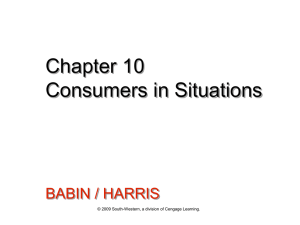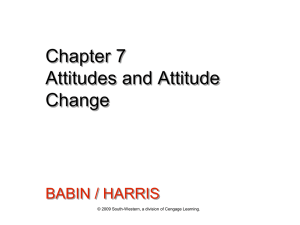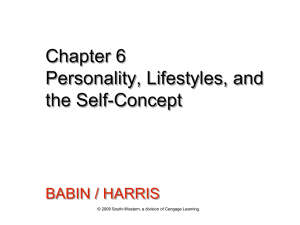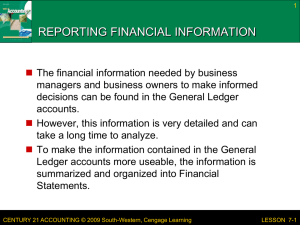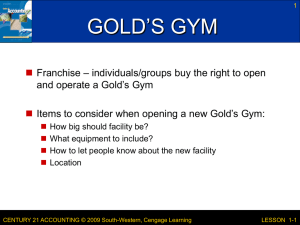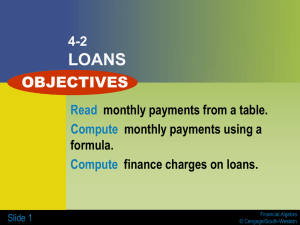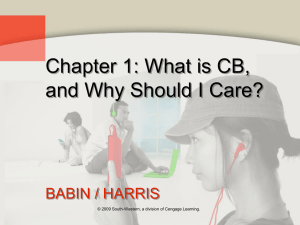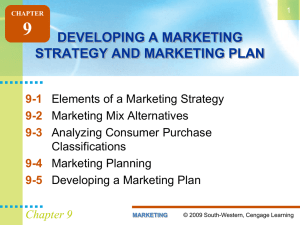Chapter 6
advertisement
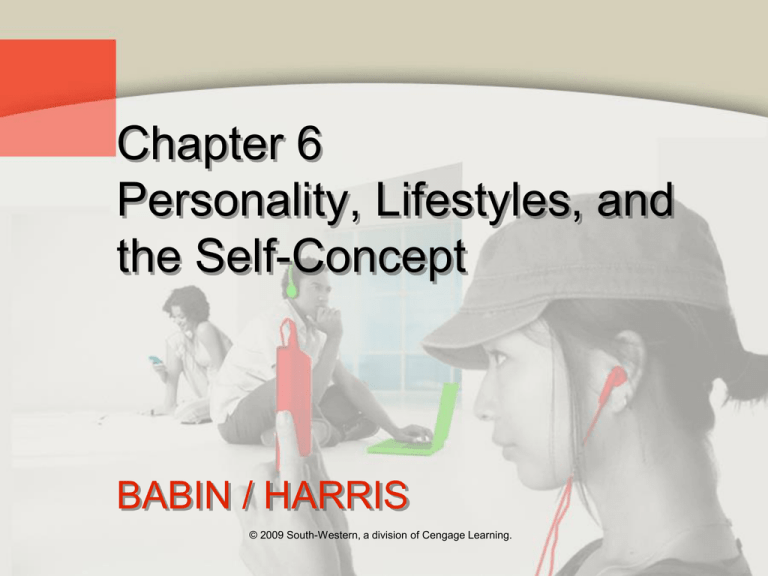
Chapter 6 Personality, Lifestyles, and the Self-Concept BABIN / HARRIS © 2009 South-Western, a division of Cengage Learning. Learning Outcomes LO1 Define personality and know how various approaches to studying personality can be applied to consumer behavior. LO2 Discuss major traits that have been examined in consumer research. LO3 Understand why lifestyles and psychographics are important to the study of consumer behavior. LO4 Comprehend the role of the self-concept in consumer behavior. LO5 Understand the concept of self-congruency and how it applies to consumer behavior issues. © 2009 South-Western, a division of Cengage Learning. 6-2 LO1 Define personality and know how various approaches to studying personality can be applied to consumer behavior. © 2009 South-Western, a division of Cengage Learning. LO1 Personality The totality of thoughts, emotions, intentions, and behaviors that a person exhibits consistently as he or she adapts to his or her environment. © 2009 South-Western, a division of Cengage Learning. 6-4 LO1 Personality Qualities • Unique to an individual • Can be conceptualized as a combination of specific traits or characteristics • Traits are relatively stable and interact with situations to influence behavior • Specific behaviors can vary across time © 2009 South-Western, a division of Cengage Learning. 6-5 LO1 Psychoanalytic Approach Id Superego Ego © 2009 South-Western, a division of Cengage Learning. 6-6 LO1 Motivational Research Era Researchers utilized tools such as depth interviews and focus groups to improve their understanding of inner motives and needs. © 2009 South-Western, a division of Cengage Learning. 6-7 Motivation Research Does this ad appeal to some deeply held motivation? © 2009 South-Western, a division of Cengage Learning. 6-8 LO1 Trait Approach • Trait – a distinguishable characteristic that describes one’s tendency to act in a relatively consistent manner. • Approaches: – Nomothetic perspective – Idiographic perspective © 2009 South-Western, a division of Cengage Learning. 6-9 LO2 Discuss major traits that have been examined in consumer research. © 2009 South-Western, a division of Cengage Learning. LO2 Important Traits Studied Value consciousness Materialism Innovativeness Complaint proneness Competitiveness © 2009 South-Western, a division of Cengage Learning. 6-11 LO2 Exhibit 6.1: Examples of Other Traits in Consumer Research © 2009 South-Western, a division of Cengage Learning. 6-12 LO2 Exhibit 6.2 Five-Factor Model © 2009 South-Western, a division of Cengage Learning. 6-13 LO2 Hierarchical Approaches • Begin with the assumption that personality traits exist at varying levels of abstraction. – Specific traits – tendencies to behave in very well-defined situations (e.g., complaint-propensity). – Broad traits – behaviors that are performed across many different situations (e.g., extroversion). © 2009 South-Western, a division of Cengage Learning. 6-14 LO2 Personology Approach • Combines information on traits, goals, and consumer lifestories to gain a better understanding of personality. © 2009 South-Western, a division of Cengage Learning. 6-15 LO2 Exhibit 6.4 Brand Personality Dimensions © 2009 South-Western, a division of Cengage Learning. 6-16 LO2 Jimmy John’s – It’s Exciting! © 2009 South-Western, a division of Cengage Learning. 6-17 LO2 Matching Consumers and Products Whattorent.com Pandora.com Stumbleupon.com © 2009 South-Western, a division of Cengage Learning. 6-18 LO3 Understand why lifestyles and psychographics are important to the study of consumer behavior. © 2009 South-Western, a division of Cengage Learning. LO3 Lifestyles Refer to the ways consumers live and spend their time and money. Useful in identifying viable market segments! © 2009 South-Western, a division of Cengage Learning. 6-20 LO3 Psychographics • Refers to the way consumer lifestyles are measured. • AIO statements: – Activities – Interests – Opinions © 2009 South-Western, a division of Cengage Learning. 6-21 Exhibit 6.5: Sample Psychographic LO3 Items for Segmenting the Bowling Market © 2009 South-Western, a division of Cengage Learning. 6-22 LO3 VALS • Values and Lifestyles • Classifies consumers into eight segments based on: – resources available – primary motivations Take the survey © 2009 South-Western, a division of Cengage Learning. 6-23 LO3 PRIZM Geodemographics • Potential Ratings Index by Zip Market • Based on premise that people with similar backgrounds and means tend to live close to one another and emulate each other’s behaviors and lifestyles. • 66 segments Find yours © 2009 South-Western, a division of Cengage Learning. 6-24 LO4 Comprehend the role of the selfconcept in consumer behavior. © 2009 South-Western, a division of Cengage Learning. LO4 Self-Concept Refers to the totality of thoughts and feelings that an individual has about him or her self. © 2009 South-Western, a division of Cengage Learning. 6-26 LO4 We Have Many Self-Concepts Actual self Ideal self Social self Ideal social self Possible self Extended self © 2009 South-Western, a division of Cengage Learning. 6-27 LO4 Self-Esteem Refers to the positivity of an individual’s self-concept. © 2009 South-Western, a division of Cengage Learning. 6-28 LO5 Understand the concept of selfcongruency and how it applies to consumer behavior issues. © 2009 South-Western, a division of Cengage Learning. Self-Congruency Does this store match your selfconcept? © 2009 South-Western, a division of Cengage Learning. 6-30 LO5 Self-Congruency Theory Proposes that much of consumer behavior can be explained by the congruence (match) between a consumer’s self-concept and the image of typical users of a focal product. © 2009 South-Western, a division of Cengage Learning. 6-31
